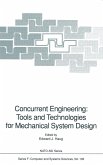Torsten Bohlin
Interactive System Identification: Prospects and Pitfalls (eBook, PDF)
40,95 €
40,95 €
inkl. MwSt.
Sofort per Download lieferbar

20 °P sammeln
40,95 €
Als Download kaufen

40,95 €
inkl. MwSt.
Sofort per Download lieferbar

20 °P sammeln
Jetzt verschenken
Alle Infos zum eBook verschenken
40,95 €
inkl. MwSt.
Sofort per Download lieferbar
Alle Infos zum eBook verschenken

20 °P sammeln
Torsten Bohlin
Interactive System Identification: Prospects and Pitfalls (eBook, PDF)
- Format: PDF
- Merkliste
- Auf die Merkliste
- Bewerten Bewerten
- Teilen
- Produkt teilen
- Produkterinnerung
- Produkterinnerung

Bitte loggen Sie sich zunächst in Ihr Kundenkonto ein oder registrieren Sie sich bei
bücher.de, um das eBook-Abo tolino select nutzen zu können.
Hier können Sie sich einloggen
Hier können Sie sich einloggen
Sie sind bereits eingeloggt. Klicken Sie auf 2. tolino select Abo, um fortzufahren.

Bitte loggen Sie sich zunächst in Ihr Kundenkonto ein oder registrieren Sie sich bei bücher.de, um das eBook-Abo tolino select nutzen zu können.
This book analyses the fundamental problems and possibilities of designing purposive mathematical models of dynamical physical objects, including a number of 'pitfalls'. It states conditions for correct identification and suggests rules and procedures for making meaningful use of any identification software.
- Geräte: PC
- ohne Kopierschutz
- eBook Hilfe
- Größe: 30.92MB
Andere Kunden interessierten sich auch für
![Genetic Algorithms for Applied CAD Problems (eBook, PDF) Genetic Algorithms for Applied CAD Problems (eBook, PDF)]() Viktor M. KureichikGenetic Algorithms for Applied CAD Problems (eBook, PDF)72,95 €
Viktor M. KureichikGenetic Algorithms for Applied CAD Problems (eBook, PDF)72,95 €![Intelligent CAD Systems III (eBook, PDF) Intelligent CAD Systems III (eBook, PDF)]() Intelligent CAD Systems III (eBook, PDF)72,95 €
Intelligent CAD Systems III (eBook, PDF)72,95 €![Concurrent Engineering: Tools and Technologies for Mechanical System Design (eBook, PDF) Concurrent Engineering: Tools and Technologies for Mechanical System Design (eBook, PDF)]() Concurrent Engineering: Tools and Technologies for Mechanical System Design (eBook, PDF)40,95 €
Concurrent Engineering: Tools and Technologies for Mechanical System Design (eBook, PDF)40,95 €![Interactive Graphics in CAD (eBook, PDF) Interactive Graphics in CAD (eBook, PDF)]() Y. GardanInteractive Graphics in CAD (eBook, PDF)40,95 €
Y. GardanInteractive Graphics in CAD (eBook, PDF)40,95 €![Model Based Fuzzy Control (eBook, PDF) Model Based Fuzzy Control (eBook, PDF)]() Rainer PalmModel Based Fuzzy Control (eBook, PDF)40,95 €
Rainer PalmModel Based Fuzzy Control (eBook, PDF)40,95 €![Advanced Modelling for CAD/CAM Systems (eBook, PDF) Advanced Modelling for CAD/CAM Systems (eBook, PDF)]() Advanced Modelling for CAD/CAM Systems (eBook, PDF)40,95 €
Advanced Modelling for CAD/CAM Systems (eBook, PDF)40,95 €![Hybrid Evolutionary Algorithms (eBook, PDF) Hybrid Evolutionary Algorithms (eBook, PDF)]() Hybrid Evolutionary Algorithms (eBook, PDF)112,95 €
Hybrid Evolutionary Algorithms (eBook, PDF)112,95 €-
-
-
This book analyses the fundamental problems and possibilities of designing purposive mathematical models of dynamical physical objects, including a number of 'pitfalls'. It states conditions for correct identification and suggests rules and procedures for making meaningful use of any identification software.
Dieser Download kann aus rechtlichen Gründen nur mit Rechnungsadresse in A, B, BG, CY, CZ, D, DK, EW, E, FIN, F, GR, HR, H, IRL, I, LT, L, LR, M, NL, PL, P, R, S, SLO, SK ausgeliefert werden.
Produktdetails
- Produktdetails
- Verlag: Springer Berlin Heidelberg
- Seitenzahl: 365
- Erscheinungstermin: 13. März 2013
- Englisch
- ISBN-13: 9783642486180
- Artikelnr.: 53385778
- Verlag: Springer Berlin Heidelberg
- Seitenzahl: 365
- Erscheinungstermin: 13. März 2013
- Englisch
- ISBN-13: 9783642486180
- Artikelnr.: 53385778
- Herstellerkennzeichnung Die Herstellerinformationen sind derzeit nicht verfügbar.
1: Introduction.- 1.1 The terminology.- 1.2 The software.- 1.3 The purpose.- 1.4 The experiment facilities.- 1.5 The model structure.- 1.6 The philosophy.- 2: Randomness, probability, and likelihood.- 2.1 Bayes' idea.- 2.2 The information contents of an experiment.- 2.3 Covariation and causality.- 3: The experiment.- 3.1 An introductory example.- 3.2 Requirements for proper experimentation.- 3.4 Dynamic systems.- 3.5 Experiments on dynamic objects.- 4: The identification problem.- 4.1 Validation and falsification.- 4.2 Model structures, data descriptions, and purposive models.- 4.3 Fitting.- 4.4 Basic identification procedures.- 4.5 Conditions for Bayesian validation.- 4.6 The origin of 'pitfalls'.- 5: Modelling.- 5.1 Parametrization.- 5.2 The parameter map.- 5.3 Algorithmic models.- 5.4 The modelling of dynamic systems.- 5.5 Internal and external models.- 5.6 Implicit and explicit models.- 5.7 Finite-memory models.- 5.8 Classification of models by purpose.- 5.9 'Black-box' and 'grey-box' models.- 6: Large-sample theory.- 6.1 Equivalent dynamic models.- 6.2 Consistency.- 6.3 Identifiability.- 6.4 Falsification in the limit.- 6.5 Proper 'black-box' identification.- 6.6 A concluding example.- 7: Validation techniques.- 7.1 Validating parametric models.- 7.2 Large-sample techniques.- 7.3 Two 'pitfalls'.- 8: Falsification techniques.- 8.1 Statistical tests.- 8.2 Unconditional falsification.- 8.3 Conditional falsification of models.- 8.4 Conditional falsification of structures.- 8.5 The Likelihood-Ratio test.- 8.6 Efficiency vs safety.- 9: Structure identification.- 9.1 Using the biassed Likelihood.- 9.2 Sequential falsification.- 9.3 Philosophy revisited: Equivalence vs goodness.- 9.4 Designing the criterion: Description vs purpose.- 9.5 Defining theoptimal order: Accuracy vs complexity.- 9.6 Model structure selection.- 9.7 Terminology revisited.- 10: A unified design procedure.- 10.1 Summary of conditions for proper identification.- 10.2 Identification procedures.- 10.3 Procedure for modelling and identification.- References.- Glossary of notations.
1: Introduction.- 1.1 The terminology.- 1.2 The software.- 1.3 The purpose.- 1.4 The experiment facilities.- 1.5 The model structure.- 1.6 The philosophy.- 2: Randomness, probability, and likelihood.- 2.1 Bayes' idea.- 2.2 The information contents of an experiment.- 2.3 Covariation and causality.- 3: The experiment.- 3.1 An introductory example.- 3.2 Requirements for proper experimentation.- 3.4 Dynamic systems.- 3.5 Experiments on dynamic objects.- 4: The identification problem.- 4.1 Validation and falsification.- 4.2 Model structures, data descriptions, and purposive models.- 4.3 Fitting.- 4.4 Basic identification procedures.- 4.5 Conditions for Bayesian validation.- 4.6 The origin of 'pitfalls'.- 5: Modelling.- 5.1 Parametrization.- 5.2 The parameter map.- 5.3 Algorithmic models.- 5.4 The modelling of dynamic systems.- 5.5 Internal and external models.- 5.6 Implicit and explicit models.- 5.7 Finite-memory models.- 5.8 Classification of models by purpose.- 5.9 'Black-box' and 'grey-box' models.- 6: Large-sample theory.- 6.1 Equivalent dynamic models.- 6.2 Consistency.- 6.3 Identifiability.- 6.4 Falsification in the limit.- 6.5 Proper 'black-box' identification.- 6.6 A concluding example.- 7: Validation techniques.- 7.1 Validating parametric models.- 7.2 Large-sample techniques.- 7.3 Two 'pitfalls'.- 8: Falsification techniques.- 8.1 Statistical tests.- 8.2 Unconditional falsification.- 8.3 Conditional falsification of models.- 8.4 Conditional falsification of structures.- 8.5 The Likelihood-Ratio test.- 8.6 Efficiency vs safety.- 9: Structure identification.- 9.1 Using the biassed Likelihood.- 9.2 Sequential falsification.- 9.3 Philosophy revisited: Equivalence vs goodness.- 9.4 Designing the criterion: Description vs purpose.- 9.5 Defining theoptimal order: Accuracy vs complexity.- 9.6 Model structure selection.- 9.7 Terminology revisited.- 10: A unified design procedure.- 10.1 Summary of conditions for proper identification.- 10.2 Identification procedures.- 10.3 Procedure for modelling and identification.- References.- Glossary of notations.







